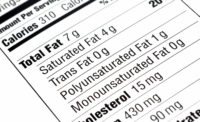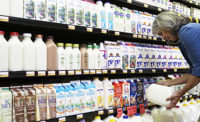Survey: How shoppers respond to packaging, labeling on crowded store shelves
The responses reveal the true importance of producing packaging and labeling techniques that are not just visually compelling, but also functionally optimized to deliver the information that consumers seek.

Brands, marketers and manufacturers constantly strive to understand consumer behavior— they struggle to measure and understand what matters to their prospective customers and what doesn’t.
A survey from Luminer, Lakewood, N.J., of 400 U.S. men and women, aged 18-65, uncovers the specific packaging and labeling features that most draw consumers’ attention to a product on the shelf.
Top 2017 packaging and labeling statistics:
- 90% of shoppers are more likely to buy a product with a peel-off instant savings coupon attached.
- 59% of shoppers say a peel-off label (coupon, recipes) on a product draws their attention.
- 68% of shoppers notice peel-off labels because they physically “stick out” from the package.
- 56% of shoppers say a recognizable logo draws their attention to a product.
- 53% of shoppers say bright attractive colors draw their attention to a product.
- 33% of shoppers are inclined to reject a product when they don’t like the label.
- 60% of shoppers are unlikely to buy a product when the label doesn’t provide enough information.
- 56% of shoppers are more likely to choose a product that uses eco-friendly/sustainable packaging over a similar product that does not.
The responses reveal the true importance of producing packaging and labeling techniques that are not just visually compelling, but also functionally optimized to deliver the information that consumers seek.
Customers love peel-off instant savings coupons
When it comes to enticing customers to buy, offering immediate savings via a peel-off coupon is the way to go. In fact, 90% of consumers say they’re more likely to buy a product that has a peel-off instant savings coupon attached to the package.
While a peel-off coupon is by far the most popular type of peel-off label, according to the survey, mail-in rebates entice 25% of consumers and a contest or a sweepstakes comes in at 24%. Twenty-two percent say that an informational label such as a recipe or serving suggestion on the label makes them more likely to buy. QR codes on a label, which require an extra step of scanning the code and visiting a webpage, do not register high as a motivator for consumers.
Peel-off labels, familiar logos, bright colors
A peel-off label adhered to the package, such as a coupon or a recipe, gets the attention of 59% of consumers, while 56% are attracted to labels with a recognizable logo and 53% say that they’re drawn to packages and labels with bright, pleasing colors. Photos of the product on the packaging label attract 41% of shoppers and large print attracts the attention of 40%.
Though most Americans are concerned about the environment, only 24% say that environmentally friendly packaging grabs their attention. A small segment, 14%, is attracted to a shiny, glossy package.
Characteristics of a standout label
Sixty-eight percent of consumers notice peel-off coupons because they “stick out” from the package, while 33% say a peel-off label looks different compared to the other labels on the shelf and 33% say it breaks up the print and images on the package.
Packaging that gets a thumbs down
When customers reject a product because they were turned off by the label design, what motivates that decision?
According to this research, 60% say it is because the label did not present enough information about the product. Meanwhile, 44% are likely to reject packaging simply because it’s an unfamiliar brand or manufacturer, and 37% report they might decide not to buy if the packaging has unappealing photos or no photos at all. While there are a variety of other factors that can drive customers away, the key takeaway is the visual aspect of your label design matters.
Great product…but that label
Thirty-two percent of consumers have disliked a label so much that they decided not to buy the product. This number further confirms that the product label is critically important in attracting shoppers’ attention.
To avoid making a big and expensive mistake with your product label, conduct market research, so you can make informed design decisions. Customer personas based on your ideal customer attributes such as age, income, gender, interests, education, values, etc. can help steer you in the right direction.
Mixed messages about eco-friendly packaging
Fifty-six percent of consumers are inclined to choose a product that uses eco-friendly/sustainable packaging over a similar product that does not. However, only 20% said they might not buy a product if it appears to be wrapped in wasteful packaging (i.e., not eco-friendly). And, 68% of survey respondents said they would NOT pay more for products that use sustainable/eco-friendly packaging.
Key takeaways for brand managers and packaging engineers
Instant savings coupons present a huge opportunity to entice a shopper to try your product. With 9 out of 10 shoppers saying a peel-off instant savings coupon makes them more likely to buy a product, it is clear that these type of multi-ply labels are a huge hit with shoppers. Use these strategically to attract new customers who may otherwise stick with their go-to brand.
Use a peel-off label to pull shoppers’ attention away from the more established brands. It’s not just instant savings coupons that get results. Fifty-nine percent of shoppers say ANY peel-off label adhered to a product draws their attention – even more so than a recognizable logo (56%) or bright packaging colors (53%). Enhance your food packaging with booklet labels containing recipe ideas or peel-off labels with grilling suggestions.
Make sure your label provides detailed information about the product. Sixty percent of consumers are likely to reject a product if the label does not provide enough information about the product, and 37% are deterred by inadequate photos and small text on the label. Learn as much as you can about your customers and potential customers, so you can understand their motives and design your label accordingly. Use creative label solutions such as expanded content labels (ECL), which include peel-and-reseal, foldout and booklet labels to provide detailed information in a small space.
Consider using eco-friendly packaging to broaden your appeal. Though a majority of consumers stated they would not pay more for eco-friendly packaging, a significant percentage (56%) said they are inclined to choose a product that uses eco-friendly/sustainable packaging over a similar product that does not. So, consider whether the use of recycled materials and more streamlined constructions can be incorporated into your packaging.
Conclusion
While the data shows that many consumers look for familiar brands, that doesn’t mean that lesser-known brands are out of luck. When your logo and brand don’t have the name recognition of your competitors (yet), the survey shows that there are plenty of things you can do to can make shoppers stop and take notice.
Looking for a reprint of this article?
From high-res PDFs to custom plaques, order your copy today!








